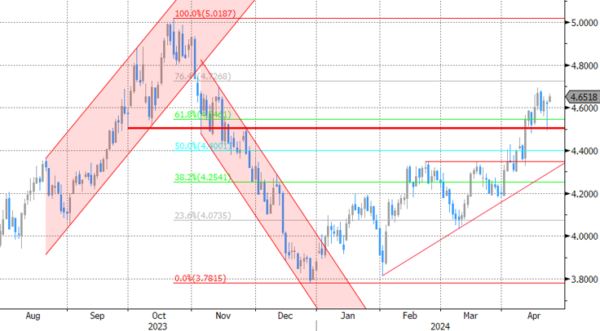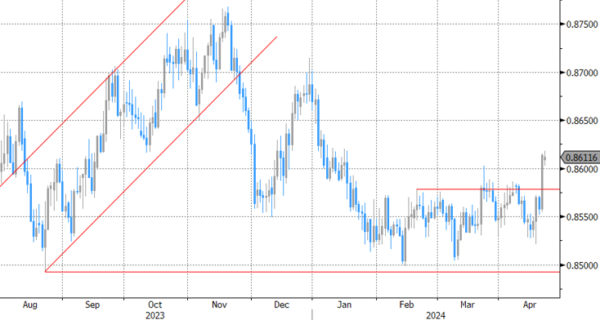Markets
German and EU swap rates yesterday tested YTD highs in absence of strong market drivers. These technical resistance levels stood their ground with rebounding stock markets (Nasdaq +1.1%) offering some counterweight as well. Unlike yesterday, today’s agenda could be an inspiring one both in EMU and in the US. April PMI confidence indicators are scheduled for release. The current dire economic outlook keeps the consensus bar rather low both for manufacturing (46.5 from 46.1) and services (51.8 from 51.5). Germany and France have been the main laggards in past months so we recall improving April German ZEW (agree, investor) sentiment and a less pessimistic tone in the latest monthly outlook by the German Bundesbank. The BuBa suggested that the nation might have avoided a winter recession. The economic situation brightened somewhat but remains weak at its core. Matching consensus or doing better could be sufficient in the current environment to push yields through resistance levels, both at the front and at the long end of the curve. European money markets are more and more coming to terms with the fact that a bumpy H2 inflation path, the Fed’s hold, somewhat better economic momentum and a higher neutral rate limit the scope for more rate cuts after June. Yesterday’s suggestion by Portuguese governor Centeno that the central bank could lower its policy rate by a cumulative 100 bps this year seems very unrealistic. Room for repositioning in the other direction (less rate cuts) could temporarily limit the downside in EUR/USD. On today’s US side of the equation we get April PMI’s as well. They are expected to hum along at 52. March new home sales and April Richmond Fed manufacturing index are on the agenda as well. Other wildcards include the start of the US Treasury’s end-of-month refinancing operation with a record volume $69bn 2-yr Note auction and Q1 earnings with eg Tesla after trading.
The Japanese yen (USD/JPY 154.75) isn’t impressed this morning by yet another verbal intervention warning by FM Suzuki nor by BoJ governor Ueda’s renewed call for a less easy monetary policy if the price trend rises towards 2% in line with the BoJ outlook. The BoJ meets on Friday and gives a new (quarterly) economic assessment. We keep a close eye on UK PMI’s and speeches by BoE chief economist Pill and BoE Haskel as well given GBP-weakness since last Friday. EUR/GBP yesterday closed at its highest level since the first trading day of this year (0.8627). The pair could advance further as the BoE aligns itself with the ECB rather than with the Fed.
News & Views
ECB Villeroy said that the central bank can’t be the solution to the funding of the green transition at it is legally impossible and would risk stoking inflation. Villeroy indicated that monetary financing of the green transition could fuel inflation just as the EMU is exiting a crisis of record high inflation. Such an approach would also be a breach of the European treaties that prohibit deficit financing. “There is a monetary illusion according to which central banks could shoulder the main part of the burden”, he said. The BoF Governor also indicated that private sources should provide the main part of the financing as fiscal sources are scarce.
Czech central bank policymaker Holub assessed that there was no need for the CNB to accelerate the pace of rate cuts amid signs of a strengthening economy and expectations of delayed and more gradual easing by the major central banks. Holub advocated a 75 bps step at the March CNB policy meeting as inflation returned to the 2% CNB target faster than expected. Since then, the Czech economy showed signs of a rebound in household consumption and better activity overall. In this respect, Holub expects the CNB to upwardly revise its 2024 growth forecast at the next meeting (from 0.6% for this year). Along with expected slower cuts in the US and EMU this suggests that keeping the current pace of 50 bps at the May 2 meeting would be more appropriate. Holub expects inflation in 2024 to develop in the upper half of the +/- 1% range around the 2% target. Stronger wage growth could still contribute to elevated service inflation. Holub also indicated that the CNB has to take into account that CZK may stay a bit weaker than expected. For now, Holub didn’t see much reason to challenge current market pricing of interest rates falling to 4% over the next year (policy rate currently 5.75%).
Graphs
GE 10y yield
ECB President Lagarde clearly hinted at a summer (June?) rate cut and seems to have broad backing. EMU disinflation will continue the next two months and bring headline CPI (temporary) at/below the 2% target. Together with weak growth momentum, this gives backing to deliver a first 25 bps rate cut. A more bumpy inflation path in H2 2024 and the Fed’s higher for longer strategy make follow-up move difficult.
US 10y yield
The March dot plot contained several hawkish elements including a symbolically higher neutral rate. In our view they set the stage for a later (September at the earliest) start of a possibly shallower cutting cycle. Upcoming CPI readings (through base effects) and resilient eco data should confirm this. US yields continue to enjoy a solid bottom across the maturity spectrum, setting fresh YTD highs.
EUR/USD
Economic divergence (US > EMU) and a likely desynchronized rate cut cycle with the ECB exceptionally taking the lead pulled EUR/USD towards the YTD low at 1.0695. Stronger-than-expected US March inflation figures forced a technical break, opening the path to last year’s low at 1.0494.
EUR/GBP
Debate at the Bank of England is focused at the timing of rate cuts. Most BoE members align with the ECB rather than with Fed view, suggesting that the disinflation process provides a window of opportunity to make policy less restrictive (in the near term). Sterling’s downside turned more vulnerable with the topside of the sideways EUR/GBP 0.8493 – 0.8768 trading range serving as the first real technical reference.

















